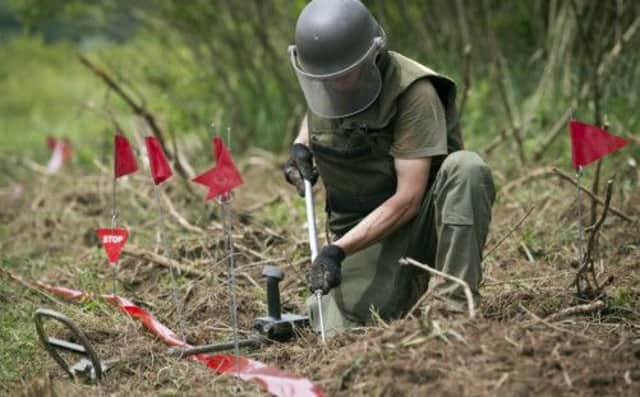Croatia: Bees taking the sting out of mine clearing


Now, unlikely heroes may be coming to the rescue to prevent similar tragedies – honey bees. Croatian researchers are training them to find the unexploded mines littering their country and the rest of the Balkans.
When Croatia joins the European Union on 1 July, it will bring numerous un-cleared minefields to the bloc’s territory. About 470 square miles are still thought to be filled with mines from the Balkan war of the 1990s.
Advertisement
Hide AdAdvertisement
Hide AdNikola Kezic, an expert on the behaviour of honey bees, sat quietly together with a group of young researchers last week in a large net tent filled with the buzzing insects on a grass field lined with acacia trees. The professor at Zagreb University outlined the idea for the experiment: Bees have a perfect sense of smell that can quickly detect the scent of the explosives. They are being trained to identify their food with the scent of TNT.
“Our basic conclusion is that the bees can clearly detect this target, and we are very satisfied,” said Prof Kezic, who leads part of a larger multimillion-euro programme, called “Tiramisu,” sponsored by the EU to detect land mines on the continent.
Several feeding points were set up on the ground around the tent, but only a few had traces of TNT in them. The method of training the bees by adding the scent of explosives with the food they eat appears to work – bees gather mainly at the pots containing a sugar solution mixed with TNT, and not the ones that have a different smell.
Prof Kezic said the feeding points containing the TNT traces offer “a sugar solution as a reward, so they can find the food in the middle”.
“It is not a problem for a bee to learn the smell of an explosive, which it can then search,” Prof Kezic said. “You can train a bee, but training their colony of thousands becomes a problem.”
During the four-year war, around 90,000 land mines were placed across the entire country, mostly at random and without any plan or existing maps.
Dijana Plestina, the head of the Croatian government’s de-mining department, said the devices represent a large obstacle for the country’s population and industry, including agriculture and tourism. In the nearly two decades since the end of the war, land mines have taken the lives of 316 people, including 66 de-miners, she said.
“While this exists, we are living in a kind of terror, at least for the people who are living in areas suspected to have mines,” she said. “And of course, that is unacceptable. We will not be a country in peace until this problem is solved.”
Advertisement
Hide AdAdvertisement
Hide AdIn 2004, Ms Filipovic and her boyfriend were on a fishing trip that took them to a river between Croatia and Bosnia.
“As we were returning hand-in-hand, my boyfriend stepped on a mine,” the 41-year-old said. “It was an awful, deafening explosion … thousands of shrapnel parts went flying, hundreds ending up in my body. He was found dead several metres away.”
She sued the Croatian government, saying the area wasn’t clearly marked as a former minefield.
It may be a while before the honey bees hit real minefields, Prof Kezic said. First, they will conduct controlled tests, with real mines but which are marked.
Rats and dogs are also used to detect explosives worldwide, but unlike bees, they could set off blasts on the minefields because of their weight.